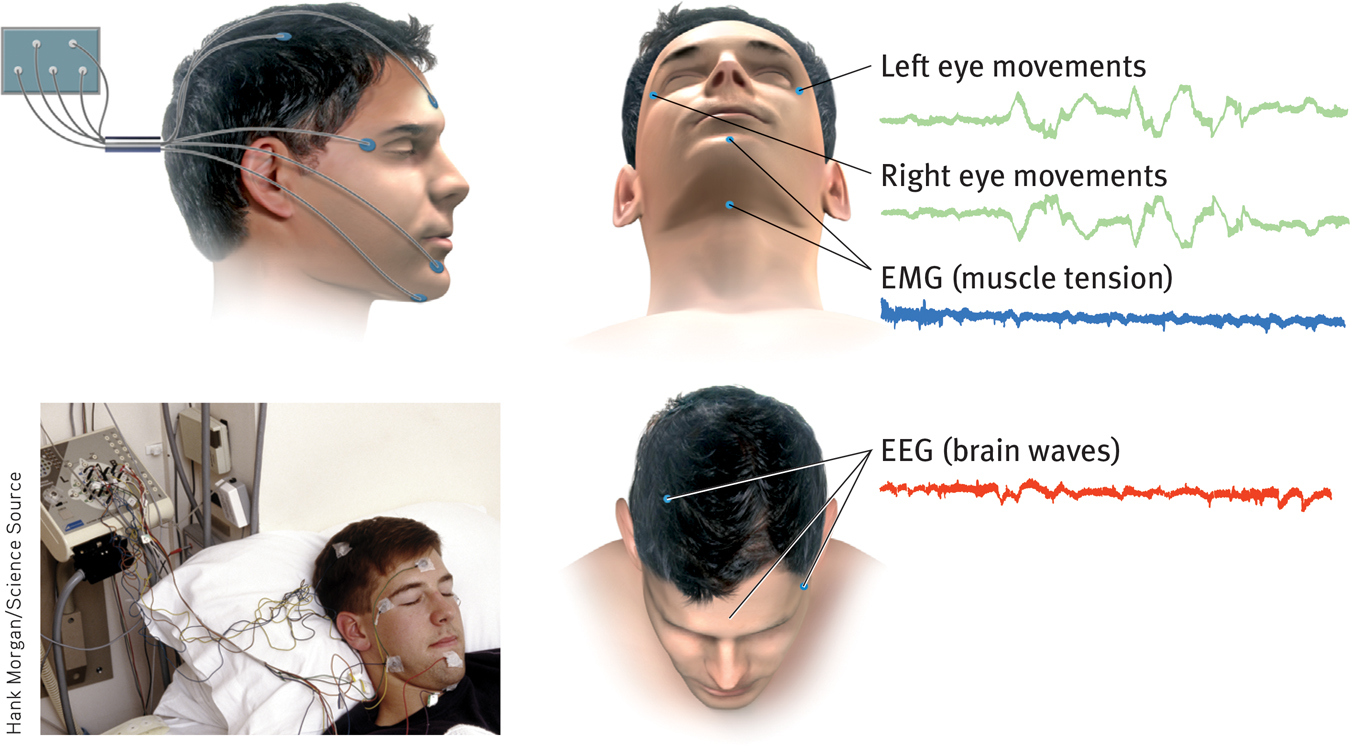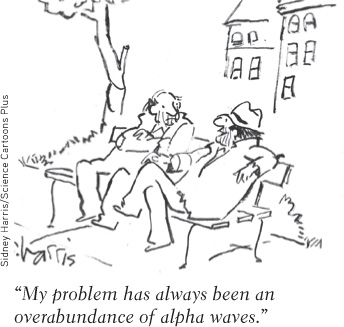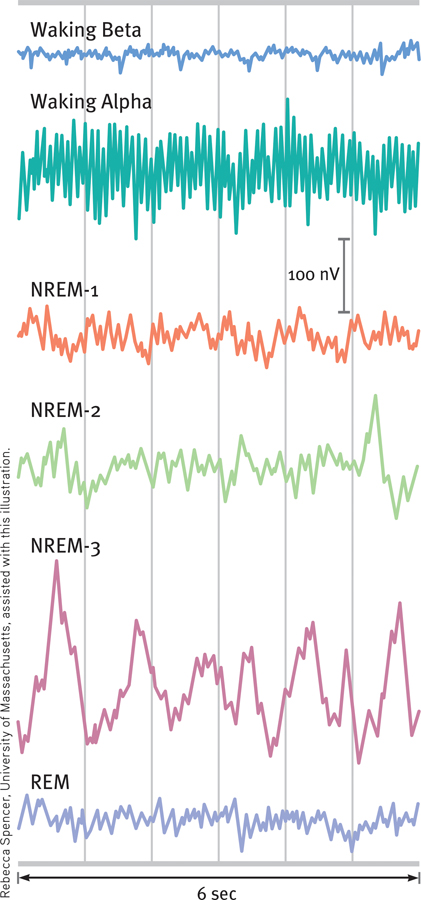9.1 Biological Rhythms and Sleep
Some students sleep like the fellow who stayed up all night to see where the Sun went. (Then it dawned on him.)
Like the ocean, life has its rhythmic tides. Over varying time periods, our bodies fluctuate, and with them, our minds. Let’s look more closely at two of those biological rhythms—
Circadian Rhythm

9-
The rhythm of the day parallels the rhythm of life—

Age and experience can alter our circadian rhythm. Most 20-
Sleep Stages
9-
Sooner or later, sleep overtakes us and consciousness fades as different parts of our brain’s cortex stop communicating (Massimini et al., 2005). Yet the sleeping brain remains active and has its own biological rhythm.
About every 90 minutes, we cycle through four distinct sleep stages. This simple fact apparently was unknown until 8-
Dolphins, porpoises, and whales sleep with one side of their brain at a time (Miller et al., 2008).
Similar procedures used with thousands of volunteers showed the cycles were a normal part of sleep (Kleitman, 1960). To appreciate these studies, imagine yourself as a participant. As the hour grows late, you feel sleepy and yawn in response to reduced brain metabolism. (Yawning, which can be socially contagious, stretches your neck muscles and increases your heart rate, which increases your alertness [Moorcroft, 2003].) When you are ready for bed, a researcher comes in and tapes electrodes to your scalp (to detect your brain waves), on your chin (to detect muscle tension), and just outside the corners of your eyes (to detect eye movement; FIGURE 9.1). Other devices will record your heart rate, respiration rate, and genital arousal.

 Figure 9.1
Figure 9.1Measuring sleep activity Sleep researchers measure brain-

When you are in bed with your eyes closed, the researcher in the next room sees on the EEG the relatively slow alpha waves of your awake but relaxed state (FIGURE 9.2). As you adapt to all this equipment, you grow tired and, in an unremembered moment, slip into sleep (FIGURE 9.3). The transition is marked by the slowed breathing and the irregular brain waves of non-

 Figure 9.2
Figure 9.2Brain waves and sleep stages The beta waves of an alert, waking state and the regular alpha waves of an awake, relaxed state differ from the slower, larger delta waves of deep NREM-

 Figure 9.3
Figure 9.3The moment of sleep We seem unaware of the moment we fall into sleep, but someone watching our brain waves could tell (Dement, 1999).
In one of his 15,000 research participants, William Dement (1999) observed the moment the brain’s perceptual window to the outside world slammed shut. Dement asked a sleep-
To catch your own hypnagogic experiences, you might use your alarm’s snooze function.
During this brief NREM-
 To better understand EEG readings and their relation to consciousness and sleep and dreams, experience the tutorial and simulation at LaunchPad’s PsychSim 6: EEG and Sleep Stages.
To better understand EEG readings and their relation to consciousness and sleep and dreams, experience the tutorial and simulation at LaunchPad’s PsychSim 6: EEG and Sleep Stages.
You then relax more deeply and begin about 20 minutes of NREM-
Then you transition to the deep sleep of NREM-
REM Sleep
About an hour after you first fall asleep, a strange thing happens. Rather than continuing in deep slumber, you ascend from your initial sleep dive. Returning through NREM-

 Figure 9.4
Figure 9.4The stages in a typical night’s sleep People pass through a multistage sleep cycle several times each night, with the periods of deep sleep diminishing and REM sleep periods increasing in duration. As people age, sleep becomes more fragile, with awakenings common among older adults (Kamel & Gammack, 2006; Neubauer, 1999).
Except during very scary dreams, your genitals become aroused during REM sleep. You have an erection or increased vaginal lubrication and clitoral engorgement, regardless of whether the dream’s content is sexual (Karacan et al., 1966). Men’s common “morning erection” stems from the night’s last REM period, often just before waking. In young men, sleep-
RETRIEVAL PRACTICE

- Why would communal sleeping provide added protection for those whose safety depends upon vigilance, such as these soldiers?
With each soldier cycling through the sleep stages independently, it is very likely that at any given time at least one of them will be awake or easily wakened in the event of a threat.
Your brain’s motor cortex is active during REM sleep, but your brainstem blocks its messages. This leaves your muscles relaxed, so much so that, except for an occasional finger, toe, or facial twitch, you are essentially paralyzed. Moreover, you cannot easily be awakened. (This immobility may occasionally linger as you awaken from REM sleep, producing a disturbing experience of sleep paralysis [Santomauro & French, 2009].) REM sleep is thus sometimes called paradoxical sleep: The body is internally aroused, with waking-
Horses, which spend 92 percent of each day standing and can sleep standing, must lie down for REM sleep (Morrison, 2003).
The sleep cycle repeats itself about every 90 minutes for younger adults (somewhat more frequently for older adults). As the night wears on, deep NREM-
RETRIEVAL PRACTICE
- What are the four sleep stages, and in what order do we normally travel through those stages?
REM, NREM-
- Can you match the cognitive experience with the sleep stage?
| 1. NREM- |
a. story- |
| 2. NREM- |
b. fleeting images |
| 3. REM | c. minimal awareness |
1. b, 2. c, 3. a
What Affects Our Sleep Patterns?
9-
The idea that “everyone needs 8 hours of sleep” is untrue. Newborns often sleep two-
People rarely snore during dreams. When REM starts, snoring stops.
Sleep patterns are genetically influenced (Hor & Tafti, 2009). In studies of fraternal and identical twins, only the identical twins had strikingly similar sleep patterns and durations (Webb & Campbell, 1983). Researchers are discovering the genes that regulate sleep in humans and animals (Donlea et al., 2009; He et al., 2009). Sleep patterns are also culturally influenced. In the United States and Canada, adults average 7 to 8 hours per night (Hurst, 2008; National Sleep Foundation [NSF], 2010; Robinson & Martin, 2009). The weeknight sleep of many students and workers falls short of this average, however (NSF, 2008). And thanks to modern lighting, shift work, and social media diversions, many who would have gone to bed at 9:00 p.m. a century ago are now up until 11:00 p.m. or later. With sleep, as with waking behavior, biology and environment interact.
Bright morning light tweaks the circadian clock by activating light-

 Figure 9.5
Figure 9.5The biological clock Light striking the retina signals the suprachiasmatic nucleus (SCN) to suppress the pineal gland’s production of the sleep hormone melatonin. At night, the SCN quiets down, allowing the pineal gland to release melatonin into the bloodstream.
Being bathed in (or deprived of) light disrupts our 24-
A circadian disadvantage: One study of a decade’s 24,121 Major League Baseball games found that teams who had crossed three time zones before playing a multiday series had nearly a 60 percent chance of losing their first game (Winter et al., 2009).
Sleep often eludes those who stay up late and sleep in on weekends, and then go to bed earlier on Sunday evening in preparation for the new workweek (Oren & Terman, 1998). Like New Yorkers whose biology is on California time, they experience “social jet lag.” For North Americans who fly to Europe and need to be up when their circadian rhythm cries “SLEEP,” bright light (spending the next day outdoors) helps reset the biological clock (Czeisler et al., 1986, 1989; Eastman et al., 1995).
RETRIEVAL PRACTICE
- The _________________ nucleus helps monitor the brain’s release of melatonin, which affects our _________________ rhythm.
suprachiasmatic, circadian